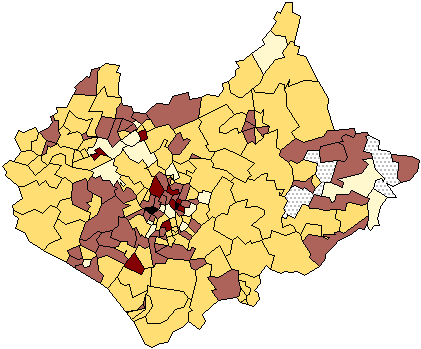https://blogger.googleusercontent.com/img/b/R29vZ2xl/AVvXsEi4JV7DGwVyeHADGQ9nnUzZ37_Sp1X99dDqDkQ_3AMxRJ1caUbFSaEU7kvvLoaBma_P88ndETMOUHVkFWwVidbiBV2UFjC0iNl-GjwL9JQRJDwCpjd5f9WWxHA-MNejqLq7DbW898aG7FO1/s1600/Lorenz_curve.jpg
This type of graph is a geovisualization of household income and expenditure. The center line is the line of equality.
Sunday, March 25, 2012
Bilateral graph
https://blogger.googleusercontent.com/img/b/R29vZ2xl/AVvXsEia3xUBrPmi0u5op0JdWh_MI6cnwwwHbX-7GgqA7tIHYdZpjmtgQHcYwRpX-H3jRWUZR4KBU-amAJwH2M0CKry3xuxEM1p6t9cxt3s6gkEVhtDjEmVQqjkNYcrdLASAs3o3VIWeuPCQ-xPt/s1600/bilateral-graph-02-lg.gif
This bilateral graph shows the percent correct for three month intervals. The increases and decreases are shown for each amount for 3 months.
This bilateral graph shows the percent correct for three month intervals. The increases and decreases are shown for each amount for 3 months.
Unstandardized choropleth maps
http://eps.mq.edu.au/courses/GEOS219/images/deaths.jpg
Different color shades are used in unstandardized chloropleth maps to represent data. These types of maps are not aerially averaged, nor do they use numerical data or ratios. This map shows deaths per 1,000 live births in Australia.
Different color shades are used in unstandardized chloropleth maps to represent data. These types of maps are not aerially averaged, nor do they use numerical data or ratios. This map shows deaths per 1,000 live births in Australia.
Nominal area choropleth map
https://blogger.googleusercontent.com/img/b/R29vZ2xl/AVvXsEiXdtpUXqJ43TRH41yZJJ7dNFGf7w8Ml3J-km9tAp42fRorn8nrs1Zgo0ZE7qrxDNZYXwqLZtEAtTZB9HnQrZVTPr739-JYFdimY0LDEtVp8e063S6dytMmc0PIz7uK6Byr0R72sYwlQKY/s1600/Figure+8_3b.jpg
This map shows quantitative differences in the access to safe drinking water. Nominal area chloropleth maps use nominal data to represent information.
This map shows quantitative differences in the access to safe drinking water. Nominal area chloropleth maps use nominal data to represent information.
Standardized choropleth maps
https://blogger.googleusercontent.com/img/b/R29vZ2xl/AVvXsEhleNWA8guoD-ne-iqQU6kBBM6tu47rwnGWW-5LdETOHg-RUmvnqanzbipp6gxZiPoAjgKvARseRFuAQkd1hODb_tEKHYPU1Tmz4vLb46yqt7A-PESIVFzmLlGN38LMBmQz1YSWKvOi2c4/s1600/standardized+c+map.PNG
Standardized chloropleth maps calculates the population per square mile so that the distribution of people can be compared. The shading shows the relative population distribution in each state.
Standardized chloropleth maps calculates the population per square mile so that the distribution of people can be compared. The shading shows the relative population distribution in each state.
Univariate choropleth maps
A univariate chloropleth map shows a single data set. This map shows water use in the U.S. by shading the states with different colors. The darker the color, the more water use, so Texas, Florida, and California are shown to use the most water.
Bivariate choropleth maps
http://www.mpassociates.gr/software/distrib/science/golden/PrismMap.gif
This bivariate choropleth map shows the distance from the Mississippi River as well as number of confirmed human cases of the West Nile Virus. Distance is shown by color and number of cases is shown by the height of each state.
This bivariate choropleth map shows the distance from the Mississippi River as well as number of confirmed human cases of the West Nile Virus. Distance is shown by color and number of cases is shown by the height of each state.
Unclassed choropleth maps
http://www.agocg.ac.uk/reports/visual/casestud/dykes/figure9.gif
The shadings are proportional to the data values in unclassed chloropleth maps. Because of this, the data does not need to be classified.
The shadings are proportional to the data values in unclassed chloropleth maps. Because of this, the data does not need to be classified.
Classed choropleth maps
https://blogger.googleusercontent.com/img/b/R29vZ2xl/AVvXsEj7r8h3t7sxbyVM4xmTwiId1z1Tcup2uRSKGej3qtaAeG4QvwgE04olvailtOMRlayYVp20aPQ_xhY6NcVIoJIYigo1QhftyCSahq6hPlijQMYlQ0LRjXAjgHD55AN6LTzO0E2HPbM7z3Q/s1600/beefmethaneJMK.gif
This classes chloropleth map uses coloring and shading to depict the beef cattle emissions in North Carolina. The darker the area, the more emissions being produced.
This classes chloropleth map uses coloring and shading to depict the beef cattle emissions in North Carolina. The darker the area, the more emissions being produced.
Range graded proportional circle map
http://www.neiu.edu/~jrthomas/377/circle.jpg
This range graded proportional circle map shows the proportion of Mexican people in each state. The circles are in different sizes proportional to the given value of the data. Texas and California have the biggest circles, therefore there are more Mexicans living there than any other states.
Continuously variable proportional circle map
https://blogger.googleusercontent.com/img/b/R29vZ2xl/AVvXsEjHFzLQP6r39_lF7gWQfAVuk6lyPXSxA7UOYBu8OlYeRokFlfT9C-eyEo1h53hjTxq03IMOYWA_vO9ogHYH33Ofpsnvg23RKt3AGfGtpauzXT96V3Wg_vN8yrnYDii6AZebp5UIRnBA39c/s1600/continuosly+variable+proportional+circle+map.jpg
Continuously variable proportional circle maps depict the proportion of a variable in a certain area. The one above shows the proportion of Hispanics in California's cities in relation to each other.
Continuously variable proportional circle maps depict the proportion of a variable in a certain area. The one above shows the proportion of Hispanics in California's cities in relation to each other.
Subscribe to:
Comments (Atom)










